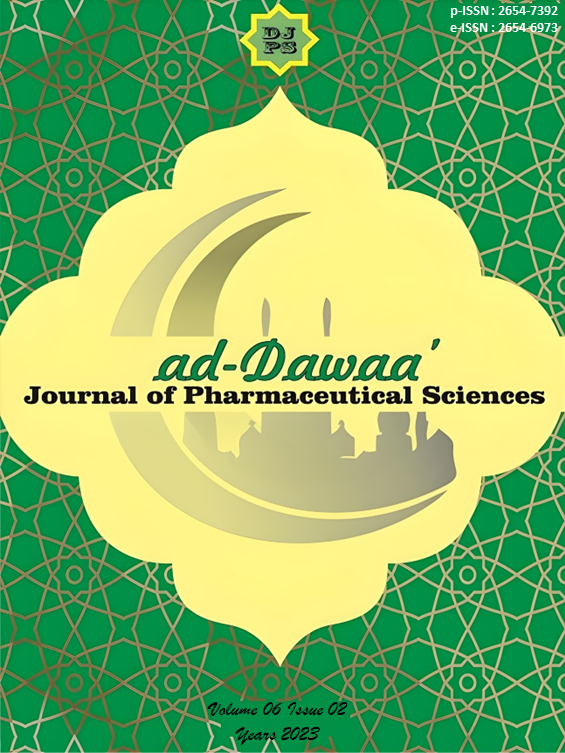Breaking Boundaries: A Comparative Analysis of Weak vs. Strong Bases in Eugenol Isolation from Syzygium aromaticum (L.) Merr. & LM Perry
Abstrak
Eugenol, a phenolic compound classified within the phenylpropanoid group, stands out as a key constituent of clove oil, boasting a myriad of biological activities. Its isolation typically involves the utilization of an alkaline solution, yet the choice of alkaline agent significantly impacts the yield of eugenol. This study delves into the impact of various alkaline solutions on the isolated eugenol content from Syzygium aromaticum essential oil, leveraging its acidic properties to form a soluble eugenol salt in an aqueous medium. Employing alkaline solutions with a concentration of 1 N, including both strong bases (such as KOH, NaOH, and Ba(OH)₂) and weak bases (like Ni(OH)₂, Al(OH)₃, and Zn(OH)₂), we scrutinized the diverse outcomes on eugenol content. Results revealed that KOH yielded the highest eugenol content at 96.91%, while Zn(OH)₂ displayed the lowest at 20.99%. Nevertheless, the potential of weak alkaline solutions in the eugenol isolation process from Syzygium aromaticum essential oil remains noteworthy. Future endeavors should focus on optimizing the ideal concentration of weak alkaline solutions for this purpose.
##plugins.generic.usageStats.downloads##
Referensi
Charan Raja, M. R., Srinivasan, V., Selvaraj, S., & Mahapatra, S. K. (2015). Pharmaceutica Analytica Acta Versatile and Synergistic Potential of Eugenol: A Review. Pharmaceutica Analytica Acta, 6(6), 1–6. https://doi.org/10.4172/21532435.1000367.
Chatterjee, D., & Bhattacharjee, P. (2015). Use of Eugenol-Lean Clove Extract as a Flavoring Agent and Natural Antioxidant in Mayonnaise: Product Characterization and Storage Study. Journal of Food Science and Technology, 52(8), 4945–4954. https://doi.org/10.1007/s13197-014-1573-6.
Didehdar, M., Chegini, Z., & Shariati, A. (2022). Eugenol: A Novel Therapeutic Agent For The Inhibition of Candidaspecies infection. Frontiers in Pharmacology, 9(13), 872127. doi: 10.3389/fphar.2022.872127.
Gojani, E. G., Bo, W., Dong-Ping, L., Olga, K., & Igor, K. (2023). Anti-Inflammatory Properties of Eugenol in Lipopolysaccharide-Induced Macrophages and Its Role in Preventing β-Cell Dedifferentiation and Loss Induced by High Glucose-High Lipid Conditions. Molecules, 28(22), 7619. https://doi.org/10.3390/molecules28227619.
Greenwood, Norman N. & Earnshaw, A. (1997). Chemistry of the Elements (2nd ed.). Butterworth-Heinemann. Bone, 23(1), 1–7. https://doi.org/10.1016/j.socscimed.2008.03.012.Social.
Hajare, S. T., Chekol, Y., & Chauhan, N. M. (2022). Assessment of Prevalence of Giardia Lamblia Infection and Its Associated Factors Among Government Elementary School Children From Sidama Zone, SNNPR, Ethiopia. PLoS ONE, 17(3), 1–17. https://doi.org/10.1371/journal.pone.0264812.
Haryadi, W. (2017). Polimerisasi Eugenol Minyak Daun Cengkeh Hasil Redistilasi, Ekstraksi, dan Fraksinasi Menggunakan Katalis Asam Sulfat Pekat. Jurnal Penelitian Dan Pengembangan Ilmu Kimia, 3(1), 50–58.
Huan, S. K. H., Wang, K. T., Yeh, S. Der, Lee, C. J., Lin, L. C., Liu, D. Z., & Wang, C. C. (2012). Scutellaria Baicalensis Alleviates Cantharidin-Induced Rat Hemorrhagic Cystitis Through Inhibition of Cyclooxygenase-2 Overexpression. Molecules, 17(6), 6277–6289. https://doi.org/10.3390/molecules17066290.
Ivanovic, T., & Harrison, S. C. (2015). Distinct Functional Determinants of Influenza Hemagglutinin-Mediated Membrane Fusion. ELife, 4(11), 1–24. https://doi.org/10.7554/eLife.11009.
Khalil, M., Hasnah, N., Abdul, W.W., &, & Pasjan, S. (2017). Analisis Kadar a – Tokoferol (Vitamin E) Dalam Daun Kelor (Moringa oleifera Lam.) Dari Daerah Pesisir dan Pegunungan Serta Potensinya Sebagai Antioksidan. 3(4), 78–88.
Kumar, D., Gupta, J., Kumar, S., Arya, R., Kumar, T., & Gupta, A. (2012). Pharmacognostic evaluation of Cayratia trifolia (Linn.) leaf. Asian Pacific Journal of Tropical Biomedicine, 2(1), 6–10. https://doi.org/10.1016/S2221-1691(11)60180-9.
Lide, D. R., ed. (2003). CRC Handbook of Chemistry and Physics (84th ed.). Boca Raton, FL: CRC Press.
Mittal, M., Gupta, N., Parashar, P., Mehra, V., & Khatri, M. (2014). Phytochemical Evaluation and Pharmacological Activity of Syzygium Aromaticum: A Comprehensive Review. International Journal of Pharmacy and Pharmaceutical Sciences, 6(8), 67–72.
Mlcek, J., Jurikova, T., Skrovankova, S., & Sochor, J. (2016). Quercetin and its Anti-Allergic Immune Response. Molecules, 21(5), 1–15. https://doi.org/10.3390/molecules21050623.
Muhammad-Lutfi, A., Zaraihah, M., & Anuar-Ramdhan, I. (2014). Knowledge and Practice of Diabetic Foot Care in an In- Patient Setting at a Tertiary Medical Center. Malaysian Orthopaedic Journal, 8(3), 22–26. https://doi.org/10.5704/moj.1411.005.
Zhang, E. Zhang, M. Xiao, C. Chen, and W. X. (2013). Novel Derivatives of Eugenol as a New Class of PPARY Agonists in Treating Inflammation: Design, Synthesis, SAR Analysis and In Vitro Anti-Inflammatory Activity. Molecules, 28(9). https://doi.org/10.3390/molecules28093899.
Putri, R. L., Hidayat, N., & Rahmah, N. L. (2014). Pemurnian Eugenol Dari Minyak Daun Cengkeh Dengan Reaktan Basa Kuat KOH dan Ba(OH)2 (Kajian Konsentrasi Reaktan). Jurnal Industria, 3(1), 1–12.
Rinaldi, L., Catelan, D., Musella, V., Cecconi, L., Hertzberg, H., Torgerson, P. R., Mavrot, F., de Waal, T., Selemetas, N., Coll, T., Bosco, A., Biggeri, A., & Cringoli, G. (2015). Haemonchus contortus: Spatial Risk Distribution For Infection In Sheep In Europe. Geospatial Health, 9(2), 325–331. https://doi.org/10.4081/gh.2015.355.
Towaha, J. (2012). Manfaat Eugenol Cengkeh dalam Berbagai Industri Di Indonesia. Perspektif, 11(2), 79–90.
Vijay Kumar, P. P. N., Pammi, S. V. N., Kollu, P., Satyanarayana, K. V. V., & Shameem, U. (2014). Green Synthesis And Characterization Of Silver Nanoparticles Using Boerhaavia Diffusa Plant Extract And Their Anti-Bacterial Activity. Industrial Crops and Products, 52, 562–566. https://doi.org/10.1016/j.indcrop.2013.10.050.
Wibowo, M. I. N. A., Aeni, N., Huda, Z. M., & Nurulita, N. A. (2017). The Hepatoprotective Effect of Ethanol Extract of Syzygium campanulatum (Korth) and Syzygium aromaticum (L) Leaf on Male Wistar Rat (Rattus norvegicus) was Induced by Paracetamol. Jurnal Ilmu Kefarmasian Indonesia, 15(2), 196. https://doi.org/10.35814/jifi.v15i2.517.
Once an article was published in the journal, the author(s) are:
- granted to the journal right licensed under Creative Commons License Attribution that allows others to share the work with an acknowledgement of the work's authorship.
- permitted to publish their work online in third parties as it can lead to wider dissemination of the work.
- continue to be the copyright owner and allow the journal to publish the article with the CC BY-SA license
- receiving a DOI (Digital Object Identifier) of the work.


1.png)